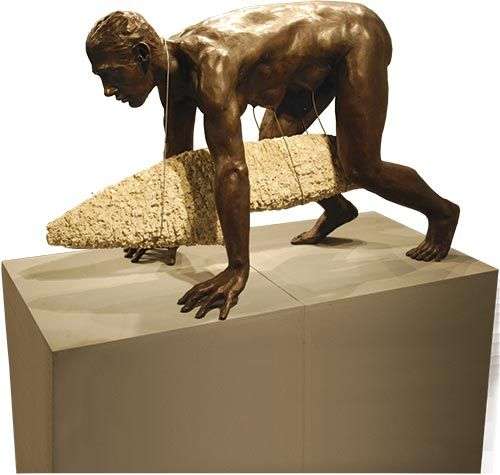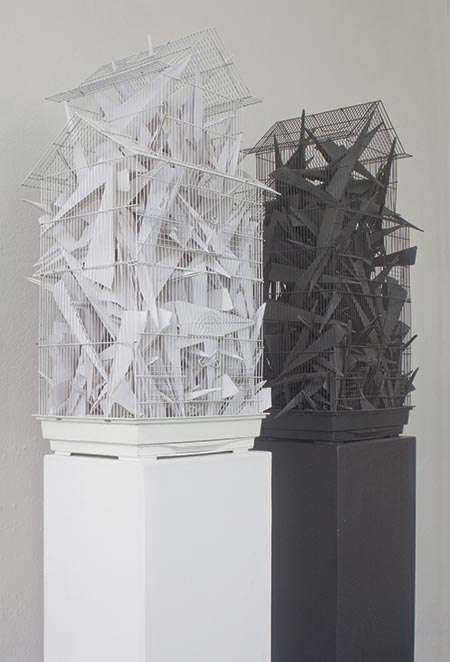Sculptor, painter, draughtsman, photographer, and engraver, Esterio Segura embraces and resorts to diverse languages, and that is why his work easily moves between the loftiest and the most popular intellectual precepts: anthropology, art history, philosophy, and world literature are some of the foundations that he makes use of, but his sharp and intelligent perspective keeps him connected and attentive to everything that happens in Cuba and the rest of the world.
As an artist, he works to ensure that his work has an international projection, but one of his most pressing concerns is to exhibit in Cuba, which in his opinion is “the most honest measure that artists have to know where their careers are going. Maybe exhibiting here is not as effective from the standpoint of finances, promoting their work, or the specialized critics, but in the most honest, most profound sense of making art, it is. It is an important, significant thermometer,” he says.
In a conversation with On Cuba, Esterio revealed that he comes from a “humble family” and not from an intellectual circle, which is why everything that he has achieved has come from study and being demanding with himself: “It is very attractive to move within a range where one minute you might be talking in slag with whoever, on the corner of your block, and the next minute enter into a philosophical discourse on José Lezama Lima”.
He emphasized that his work is conceived for many interpretations, but above all, it is focused on the search for the universal. He underscored that, for example, the immigration issue involves much of the world, and the way it is addressed in art does not need to be sad, but necessary: “As islanders, we think that what happens with us only has to do with us and that it doesn’t happen to anyone else. And that’s not true. Emigrating is important and essential in some cases. There are many phenomena in Cuba that also occur in other parts of the planet, and they are normal. My work refers to that, not in a localized way, but as something universal, inherent to human beings.”
The work of Segura, who is also a graduate of the Elementary Art School and the Professional Art School, both in Camagüey, can also be categorized as markedly conceptual. As a sculptor, and at this time, his work leans toward large scale; and that is why, little by little, he is making a dream come true: finishing Studio Esterio, an all-encompassing project that gives him the space to dream and make his work a reality.
It is common for artists to work in series, but Esterio prefers to use what he calls “blocks,” which are like takes of a supposed Complete Work. In fact, his ideas are structured on literature: “Occidente tropical” / Tropical West (I), “Mística del resguardo y la gozadera” / Mysticism of reserve and pleasure (II), “Sobre cómo aprender a caminar la tierra” / About how to learn how to walk the earth (III), “Habanos libres” (IV), “Los secretos” / Secrets (V), “Espacio ocupado por un sueño” / Space occupied by a dream (VI), “Cacerías” / Hunting parties (VII), “No todo lo que vuela se come” / Not everything that flies is eaten (VIII) and “Submarino hecho en casa” / Homemade submarine (IX), are some of the pieces that make up the pictorial discourse of this artist, who said that he is now concentrating on “Turismo político” (Political tourism), a block that, like the others, “defines lines of investigation with carefully conceived systems of symbols.” But perhaps one of the defining elements of Segura’s esthetic is the internal connection between these apparently very different blocks, a bridge that reconnects and combines the discourse, making it all-encompassing.

Giving a title to each piece is another of his obsessions, because he believes that “the public needs a door to enter, and one assumes that behind a work there is always a thought, a reflection, a reason for being, not a machine that repeats clichés, but an idea that is there as a real, intellectual resource,” he emphasized.
On the other hand, Esterio’s work exudes memory and recycling, because he considers himself indebted to history and universal knowledge, which “must be respected and revisited constantly. It is important to be clear not only about the meaning of the word Earth but also everything that it implies and sustains,” he said.
At this time, his installation Good bye my love—comprising 12 hearts, and which will be shown in five U.S. cities—is in Greenwich; very soon, his prototype of Submarino Cadillac XXI (Cadillac Submarine XXI), which is part of the Submarino hecho en casa project, will be on exhibit at New York’s Rubin Foundation. Both pieces were seen at the 11th Havana Biennale, in May-June of last year.












